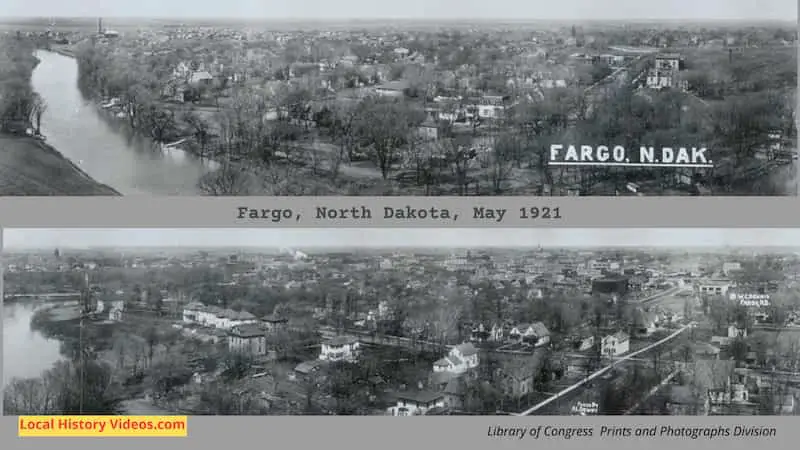Glimpse history through old images of Bismarck in North Dakota.
In the early days, the settlement in the Dakota Territory was known as Edwinton. It was changed to Bismarck in June, 1873, a successful attempt to draw the attention of the German capital to the Northern Pacific Railroad, then under construction. The city became the State Capitol in 1883, and then on 2 November 1889 North Dakota was founded.
Bismarck in 1883
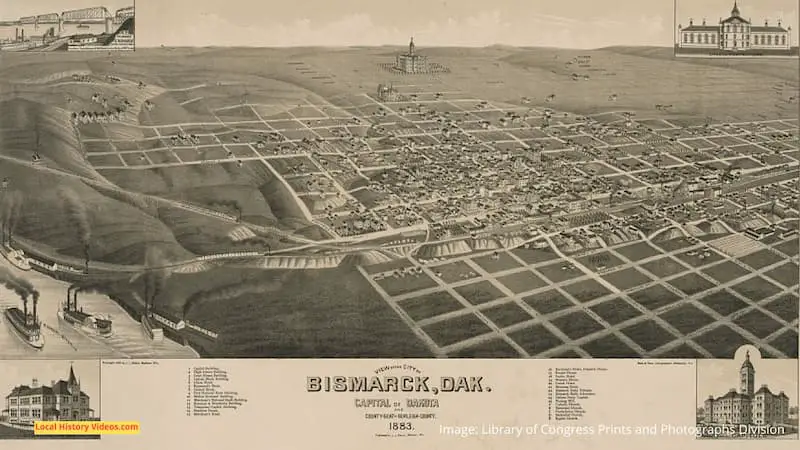
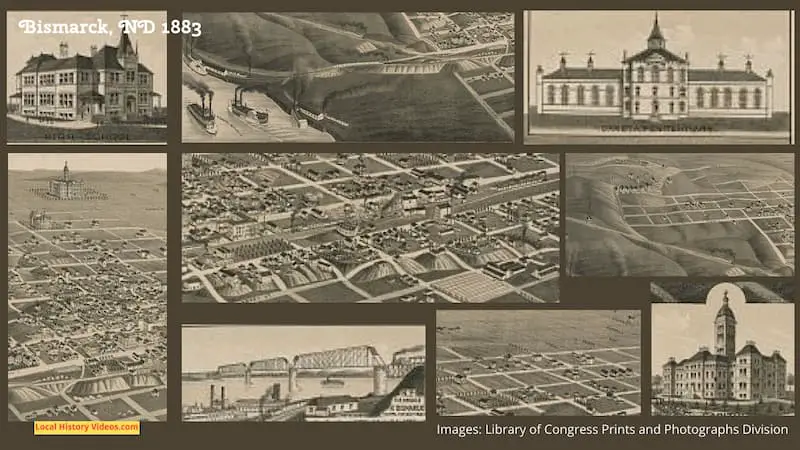
Old Photos of Bismarck DT
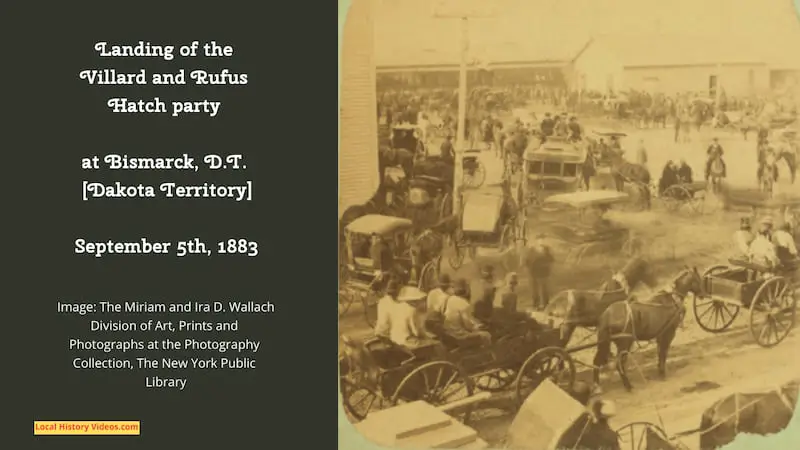
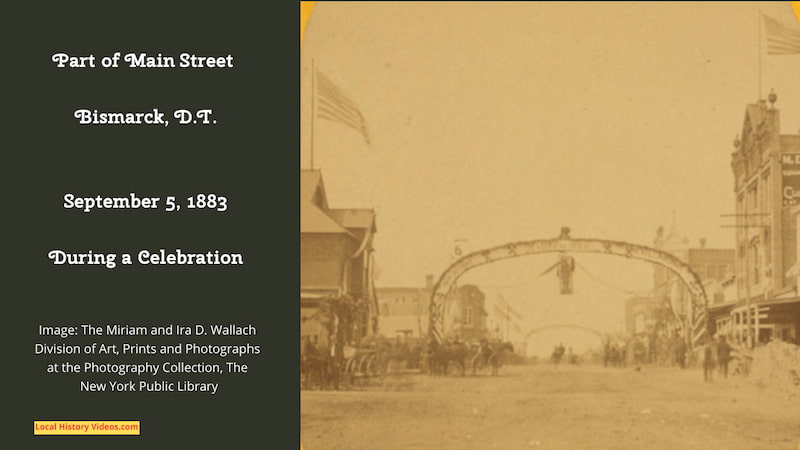
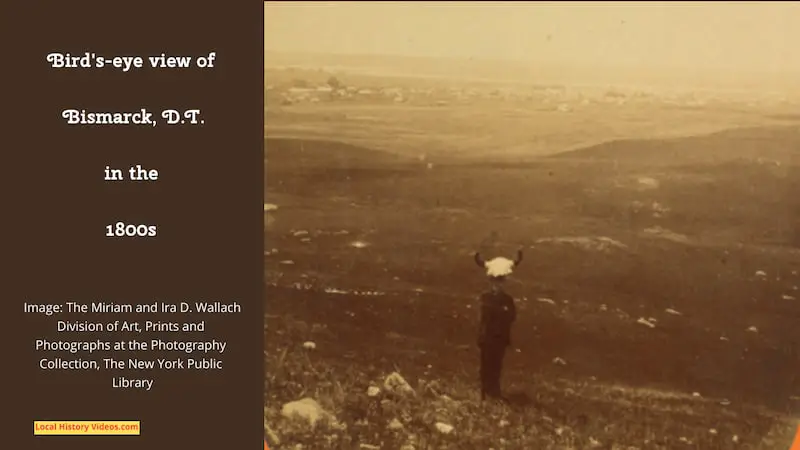
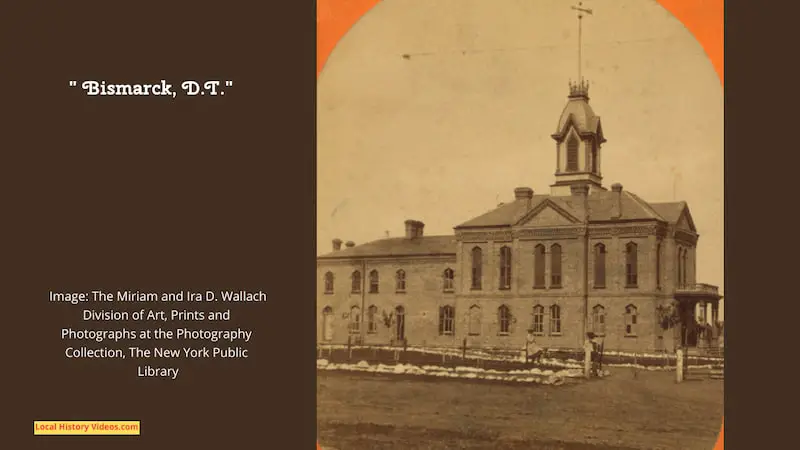
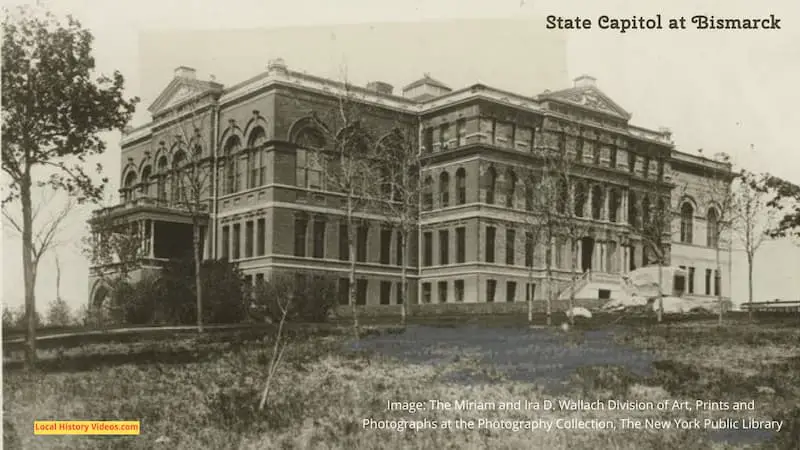
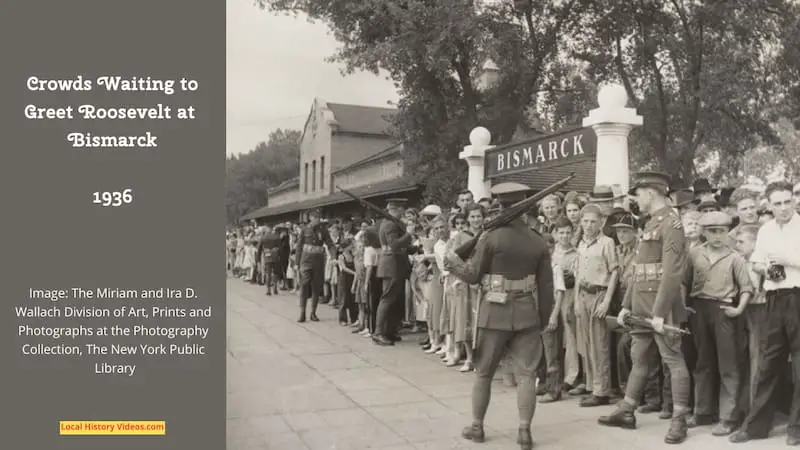
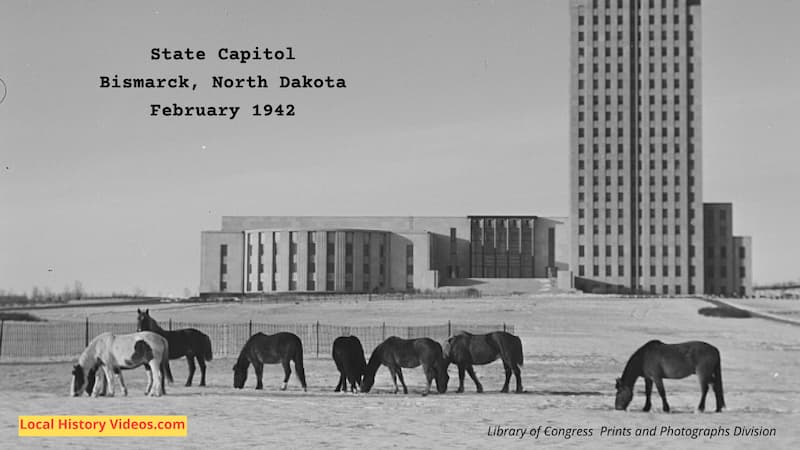
Buffalo
An extract from Page 34 of “North Dakota, History and People, Volume 1” by Colonel Clement A. Lounsberry, Founder of the Bismarck Tribune. Published in 1917 by the S.J. Clarke Publishing Company. Page 34:
“Gen. William T. Sherman estimated that the buffalo between the Missouri River and the Rocky Mountains at the beginning of the construction of the Pacific railroads numbered 9,500,000.
The bones of the animals were afterwards gathered by settlers and shipped out of the country by train loads and down the river by ship loads.
It was the privilege of the writer in 1887 to examine a pile of buffalo bones at Minot, N. D., brought in from the adjacent prairies. The pile was measured, and the weight of bones belonging to a single animal obtained, and it was found that one pile represented over seven thousand buffalo.
Like shipments were being made from other stations, and it was estimated that the bones which had been and were being gathered in North Dakota represented over two million animals.
Entire trains were loaded at Bismarck in the early days with buffalo and other hides, from the steamboats that came down the river.”
Old Bismarck
Step back to a time when horses and carts stopped outside wooden stores and hotels on dirt roads, with this showcase of old photos of Bismarck.
At the time, North Dakota didn’t exist. Bismarck was then part of the Dakota territory.
It’s surprising how quickly elegant buildings arose in these early days of the city’s existence.
Vintage Photos of Bismarck, North Dakota, From The Late 1800s – Chubachus on YouTube
Bismarck’s Blizzard 1966
North Dakota was hit by blizzards March 2-5, 1966. As things settled down, Thomas Wendelin Schneider (1907-2004) recorded the piles of snow settled on the streets of Bismarck, and people’s attempts to dig out their cars.
March 1966 Blizzard in Bismarck, North Dakota (Original 8mm footage) – shari g on YouTube
Bismarck in 1981
Take a flight over Bismarck’s streets and landmarks in 1981, when there is little development north of the Capitol compared to today.
Historical: Aerial of Bismarck, North Dakota, filmed in 1981 – Basin Electric on YouTube
1870s Trouble
Page 484 of “Early history of North Dakota; essential outlines of American history” by Lounsberry, Clement A. (Clement Augustus Lounsberry, 1843-1926), Published 1919:
“Lounsberry being absent, Jordan and Singhiser were responsible for the articles which led to the midnight raid on Bismarck by members of the Seventh United States Cavalry, resulting in the death of Dave Mullen.
Dave Mullen and Jack O’Neil were running a dance hall at Bismarck. There were several shooting scrapes at their place, some resulting fatally, and the Tribune editorially urged the formation of a vigilance committee to deal with the lawless characters, in the absence of any civil organization.
Soon after the Tribune containing this article appeared both Mullen and O’Neil, heavily armed, approached the Tribune office. Colonel Lounsberry met them and said he had heard that they threatened to do some shooting on account of the Tribune’s position; that if there was any shooting to be done the quicker it commenced the better it would please him; that he had heard bullets fly before.
They said they had come to talk it over; that they had been run out of several places and they had come to Bismarck determined to go no farther; that they expected to die right there and to die with their boots on; that they looked upon every stranger as an officer hunting for them or as some one gunning for them, and were determined that no one should get the drop on them; that this accounted for some of the shooting; that they would try to avoid any unnecessary trouble but did ask that the editor refrain from inciting attacks upon them, which they thought articles of that kind might have a tendency to do.
The force of this argument was recognized. County organization followed in a few days and the evil was remedied to some extent. Both lost their lives as they had anticipated. Mullen was killed by the Seventh Cavalry which came in search of one accused of murder, when Mullen fired on them and was killed by a volley from the soldiers.
O’Neil was killed later by “Paddy” Hall, who was lying in wait for him between two buildings.”
Scandal at Bismarck
Pages 491 to 494 of “North Dakota, History and People, Volume 1” by Colonel Clement A. Lounsberry, published in 1917, is titled “Early History of Bismarck Post Office by Linda W. Slaughter”.
“In December, 1872, the people of Edwinton, now Bismarck, tired of uncertainties in the military mail service, then carried by the quartermaster at Fort Abraham Lincoln, petitioned for the establishment of a mail route from Fargo to Edwinton and for the establishment of a post office. They also petitioned for my appointment as postmaster, which petition was endorsed favorably by the military authorities at Fort Abraham Lincoln.
The post office was established February 7, 1873, but Maj.S. A. Dickey, then post trader at Fort A. Lincoln, whose brother was in Congress from Pennsylvania, received the appointment as postmaster.
Fort A. Lincoln was then known as Fort McKean, and as a post office was established at that point soon afterwards Major Dickey could not hold the office at Edwinton as he resided beyond the delivery of the office. He resigned in my favor and I opened the office in March, 1873, as his deputy.
It was then held that a married woman could not file a bond, so my husband, Dr. B. F. Slaughter, was appointed in April, and in August I became his assistant in name, but had full charge of the office for him as I had previously had for Major Dickey.
The salary was fixed at the munificent sum of $12 per annum.
In June, 1873, the office was changed in name from Edwinton to Bismarck, so named in order to attract the attention of German capital to the Northern Pacific Railroad, then under construction. The great chancellor acknowledged the compliment in an autograph letter to Secretary Wilkinson of the Northern Pacific Railroad.
In the meantime Doctor Slaughter had gone to Washington and so impressed the department with the importance of the office that the salary was raised to $790 for the year 1874.
There were then rumors of corruption in connection with freighting, contracting and in the Indian and military traderships on the Missouri River, and Ralph Meeker put in an appearance with credentials from James Gordon Bennett of the New York Herald, with instructions to investigate and report the facts as to the alleged abuses at the Fort Berthold Indian Agency and other points.
He brought to me letters of introduction asking my aid to secure him employment at the Berthold Agency in order that he might have better opportunities for investigation. This I accomplished through the help of a commandant of one of the upriver posts, and Meeker went to work as a common laborer on the agency farm, under the assumed name of J. D. Thompson.
His letters were dated Bismarck and mailed at this office, having been sent undercover to me for that purpose.
One of these letters contained a terrible arraignment of Orville Grant, brother of the President, for his conduct of the Missouri River post traderships. These letters created a sensation in Bismarck and at the adjacent posts, and, indeed, throughout the country, and every effort was made to discover their author.
Threats of violence were even made should he be discovered. At length an observant route agent, as the railway postal clerks were then called, reported that I was the author. Mindful of the danger to the actual author should the truth be known, I did not deny the report.
Orville Grant hastened to Washington and secured my summary removal and the appointment of a gentleman associated with him in the Fort Stevenson tradership as my successor.
There was commotion among the people of Bismarck when the truth came to be known. Public meetings were held and a petition sent for my reinstatement.
The old cannon, still owned by the city, which used to be a part of the armament of the Ida Stockdale, was planted on the square where the band stand now is and joined in the general protest made by vigorous speakers.
They adjourned the public meeting to the post office where they assured me of their confidence and support.
The commandants of the military posts,who received their mail through the Bismarck post office, also sent protests against my removal.
The Herald correspondence had been instigated by members of the United States Senate who feared that an expose of the abuses of which they were cognizant would mean the downfall of their party unless the system of farming out the traderships existing under General Belknap could be stopped.
President Grant with his well known fidelity to friends, refused to even listen to the complaints. It was for that reason that the party leaders determined to make the expose even if the President’s own brother should be involved. When the news of my removal reached these gentlemen they sought an interview with Postmaster-General Jewell, and I was reinstated.
A new commission dated August 15, 1875, was afterwards sent me, with a kind personal letter from the postmaster-general.
About this time the actual writer of these sensational letters, who had been steadily following the plow on the agency farm, was discovered. He narrowly escaped assassination at the agency and made his way to Fort Stevenson whence he was sent under escort to Bismarck.
His discovery caused a revolution in my favor and those who had previously been my enemies became my friends.
On July 17, 1873, the county commissioners of Burleigh County appointed me county superintendent of schools and in November I was elected to that position by the people.
A question having arisen as to whether I was eligible Chief Justice Peter C. Shannon decided that a woman who had the qualifications of an elector as to residence and in other respects than as to sex, and was possessed of the scholarly attainments requisite, was eligible.
My right to hold two offices was later questioned and in order to settle the question I wrote the postmaster general and his reply was that “the annual salary of your office so nearly approximates $1,000 that it is not deemed expedient for you to accept the office of county superintendent of schools. “Where upon I wrote this, my resignation:
“Bismarck, Dakota, January 29, 1873.
“Hon.Marshall Jewell,Postmaster-General,
“Washington,D. C.
“Dear Sir: I hereby tender my resignation of the office of postmaster at Bismarck, Dakota, in favor of Clement A. Lounsberry of the Bismarck Tribune, to take effect at the close of the present fiscal year, June 30,1876. I resign the office because a sufficient allowance is not made for clerk hire and the duties of the office have become too onerous for me. I recommend Colonel Lounsberry for the position because he is a man of integrity and popular with our people, as I should regret to see the office to which I have devoted so much time and care, fall into unworthy hands.
“With grateful remembrance of your past kindness,and wishes for your future, I am sincerely your friend,
“LINDA W. SLAUGHTER,P. M.,
“Bismarck,Dakota.”
At this time I appointed F. D. Bolles assistant postmaster, and the office was at once moved to the Bismarck Tribune office, where he was employed as a printer.
Later my resignation was amended to take effect April 1,1876, when Colonel Lounsberry was appointed and served until his resignation in November, 1885.

